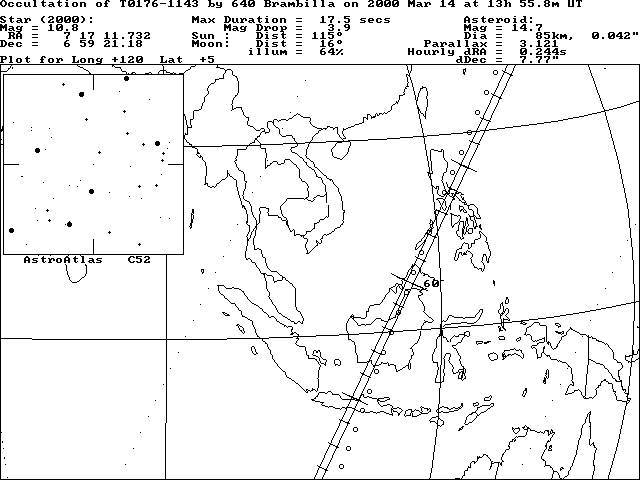ASTROMETRIC UPDATE:
OCCULTATION BY (640) BRAMBILLA - 2000 MARCH 14
THIS UPDATE REPLACES THE PREVIOUS UPDATE OF 8 MARCH.
CHECK THIS PAGE REGULARLY FOR FURTHER UPDATES AND CHANGES TO THE TRACK.
YOU MUST RELOAD THIS PAGE USING YOUR BROWSER'S
RELOAD/REFRESH BUTTON TO OBTAIN UPDATES!
[Prediction by Edwin Goffin]
[Prediction using OCCULT software]
[Detailed finder chart by Jan Manek]
Goffin's predicted path covers eastern Tasmania, a path running from the Gippsland region of Victoria through to the Cairns area of far north Queensland before crossing Papua New Guinea near Port Moresby. The path generated in OCCULT lies a full 1.1" to the west and around 4.5 minutes earlier. It misses the Australian land mass by around 100 km from Exmouth in Western Australia, crossing the island of Lombok, Sumbawa and western Sulawesi in Indonesia and clippping the south eastern portions of Mindanao in the Phillipines.
UPDATE: 14 March 2000
This prediction update is supplied by Jan Manek of the Stefanik Observatory, Prague, and is based on USNO/Flagstaff and TMO astrometry for the minor planet and the TYC star position.
Summary:
The update suggests a shift to the west of around 1.4" relative to Goffin's predicted path and around 1 minute earlier. This lies around 0.3" to the west of the path suggested by OCCULT and 3 minutes earlier. The path misses the Australian land mass by around 600 km from Exmouth in Western Australia (13:51 UT), crosses central Java near Surabaya (13:55 UT), Kalimantan (Borneo) (13:57-14:00 UT), along Palawan (14:02) and southern Luzon just south east of Manila in The Phillipines (14:04 UT). As such this path is very similar to the previous update with the difference being around 30 seconds later.
THE EVENT AT ONE GLIMPSE:
- Date and approx. UT time of event: March 14, 2000 @ 14:00 UT
- Magnitude of target star: 10.8
- Magnitude drop [mag]: 3.9
- Estimated maximum duration [s]: 17.5
- Path description: See above.
- Goffins original chart reference: A00 0330
The Occultation Path:
- Approximate width [km]: 100 km
- Uncertainty [path widths]: 3.5
- Uncertainty in time [s]: 70 !
- Map: See below
- Remarks: Uncertainities are given on the basis of the nominal star position errors and the expected asteroid positional accuracy.
- Circles along the path are OCCULT calculated exact centerline points.
Data for the target star:
- Name: TYC 176 1143 - 1 = GSC 176 1143
- Constellation: Canis Minor
- J2000 position [h,m,s; o,',"]: 7h 17m 11.732s; +06o 59' 21.18"
- Position source: Tycho 2
- Estimated accuracy ["]: 0.08" (0.05", 0.07")
- V mag [mag]: 10.75
- B-V [mag]: +1.31
- Remarks:
- The target star is 2.8 degrees south west of beta CMi (Gomeisa). It lies around 40' to the WSW of 5.9 mag star SAO 115269. To see a more detailed finder chart, click here.
Data for the minor planet:
- Number, name: (640) Brambilla
- Approx. diameter [km]: 85
- Source of used astrometry: USNO/Flagstaff (Ron Stone), TMO (Bill Owen)
- Number of used observations: 58 USNO, 2 TMO
- Number of rejected observations: 12 USNO
- Time covered by the observations: 1998 09 18 - 2000 03 04
- RMS residuals ["] (RA,DE): 0.08", 0.09"
- Estimated positional accuracy at epoch of event ["]: 0.09"
Data for the event:
- UT date and time of least geocentric approach: 13:55.8 UTC
- Approx. V mag of minor planet at event [mag]: 14.7
- Geocentric parallax of minor planet ["]: 3.121
- Magnitude drop [mag]: 3.9
- Estimated maximum duration [s]: 17.5
- Apparent motion of minor planet ["/h]: 8.59
- Angular distance to moon, phase of moon [deg,%]: 16, 64%
- Update computed by: Jan Manek

IMPORTANT NOTE!
Astrometric updates such as these should not be taken as definitive, but rather only as an indication of where the true track may lie relative to the original predicted track. Observers must bear in mind that later astrometry, in which the target star is measured in the same field as the asteroid, may still reveal substantial changes to the predicted track and time of the event. For this reason it is most important that observers far from the predicted track still monitor the event.
Use these links for further information:
[Planetary Occultations]
[Using the Predictions]
[Observing Details]
[Timing Details]
[Reporting Details]
[Report Form]
[Asteroid Occultation Results]
This page may have been updated since 14 March 2000.
Hit your browser's RELOAD button to get the latest version.
[Site Map]
[What's an Occultation?]
[Total Occultations]
[Grazing Occultations]
[Planetary Occultations]
[Jovian Satellite Eclipses]
[Timing Occultations]
[Reporting Observations]
[Coming Events]
[Software]
[About Us]
[Publications]
[Membership]
[Links]
[Top of Page][Return to Home Page]
